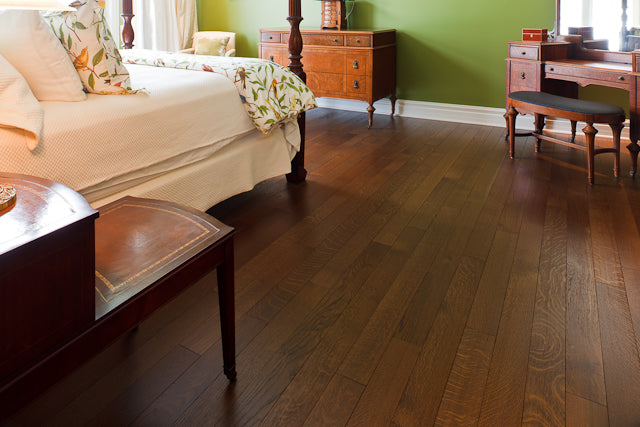 Download Full PDF: Click Here
Download Full PDF: Click Here
Plain Sawn

Plain sawn is the most commonly used method of sawing lumber for a number of reasons. It provides relatively good yield with little waste and a larger percentage of clear, sapwood pieces free of knots. The goal of sawing lumber this way is to avoid knots. The sawyer turns the log and cut the board from the clearest edge. This is typically done by sawing around the outer portion of the log trying to avoid the heartwood in the center. The clear boards on the outer portion of the log are known as the “sapwood” and are traditionally more valuable than the dark “heartwood” pieces in the center. This method will produce wider boards than quarter sawn but not as wide as live sawn.
The grain is very open and runs across the width of board between a 0-35 degree angle. Since wood expands and contracts in the direction of the grain, the plain sawn moves across the width of the board making it the least stable method of sawing lumber. This is why we only offer solid plain sawn flooring up to 4” wide. Plain sawn is what we typically associate to a traditional red oak hardwood floor.
Quarter & Rift Sawn

Quarter and rift sawn is far less common than plain sawn, especially in hardwood flooring. It is not unusual to see quarter sawn used for antique furniture because of its stability and unique grain patterns. The purpose of sawing quarter sawn lumber is to create a board that has a grain pattern that runs vertically. This is achieved by sawing the log into four pieces down the center and flipping the remaining pieces back and forth to cut the boards so the growth rings run perpendicular to the width of the board. This is the most dimensionally stable method of sawing lumber. The shrinkage and expansion is not across the width of the board but rather in the height, which across a ¾” piece of flooring is very minimal. The grain is extremely unique. It is wavy and tight and not open and busy like a plain sawn piece.

The medullary rays coming from the centre of the long are exposed and really dance across the width of the board. This unique feature is further accentuated in a distressed finish. There is much more waste in quarter sawn, and because of the process the boards can’t be quite as wide. However, we have done quarter sawn flooring in boards up to 8”; it just requires a very large log. When we sell quarter sawn flooring it is typically around 75% quarter sawn and 25% rift sawn. We can do either strictly quarter sawn or strictly rift sawn, but at a higher price.
Rift Sawn Oak
Rift sawn is very similar to quarter sawn but has a very minimalistic straight grain. The growth rings on the board run at a 45 degree angle and the medullary rays are not visible. Because of its simplicity, rift sawn flooring tends to provide a very modern look. Whereas, plain sawn and quarter sawn provide a more classic, traditional look. The rift sawn boards are the remaining cuts from the quarter sawn process. If you look at the cross section of the log, the two pieces to the center of the log are quarter sawn, and the remaining pieces are rift sawn. It is very difficult to obtain very wide rift sawn boards and the widest we typically make it is 3-1/4”.
Live Sawn

Live sawn is a very unique cut of wood which combines the grains found in plain sawn, quarter sawn, and rift sawn. This is an old method of sawing lumber used by olde world European Craftsman. To make live sawn, the sawyer slices the log directly through.

This method does not try to avoid any knots or the heartwood pieces. It provides a very rustic look with a lot of knots and other unique character. The grain pattern typically ranges from quarter sawn on the outside of the log to plain sawn in the center. This method of sawing provides the least amount of waste because the entire log is utilized. It also allows us to cut very wide boards. Since a high percentage of the board is quarter sawn, it is very stable, which allows us to make it in boards up to 11.5” wide in solid hardwood flooring. Because of its rustic character and stability, live sawn is the ideal hardwood floor for a cottage or a summer home. Quite often, when clients are trying to achieve a very rustic look they will use several different board widths to emulate the old fashioned floors where every board in the tree was used. When finishing the live sawn, we typically use a distressed or a two pass finish because these finishes really bring out the character in the wood and add to the olde world charm.

 Download Full PDF: Click Here
Download Full PDF: Click Here